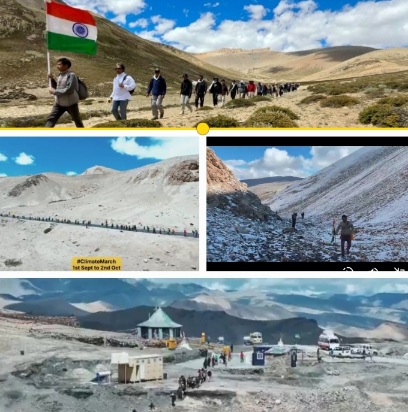Day 2024: A Call for Urgent Action to Protect the Fragile EcosystHimalayanem
Shimla/Leh, September 9, 2024 — As the world faces the escalating effects of climate change, Himalayan Day 2024 observed here today across Himalayan states turned out to be a low key affair.
But the 1000 km long Leh-Delhi Climate March of Ladakhis led by its innovator Sonam Wangchuk has brought the spotlight on the Himalay- its retreating glaciers, extreme weather events including flash floods, cloud bursts and avalanches with indigenous people facing their a combined heat.
Sonam Wangchuk has been urging the PM of India and global leaders to pay attention to Himalayan communities who are suffering the most by the climate change.
He has appealed from the Tanglang Pass at 17400 ft to adopt simple life style reducing carbon foot prints. He has sought Protection of indigenous people of Ladakh under sixth schedule of Indian constitution.
The NGO like Integrated Mountain Initiative active in all the Himalayan states have been spreading awareness about environment and sustainable development by teaming up with the state governments and local communities.
IMI has been batting for responsible and sustainable tourism and bringing the primary polluters on board and pressing upon government establishment to go for waste and water efficiency aunts, said IMI President Ramesh Negi.
The avarious institutions including the Himalayan Forest Research Institute (HFRI) in Shimla, ICIMOD Kathmandu have also brought much-needed focus on the critical state of the Himalayas.
Celebrated annually on 9th September since its inception in 2014, the day serves as a reminder to safeguard the Himalayan air, water, forests, and biodiversity.
The HFRI Shimla saw participation from forestry experts, scientists, and government officials who emphasized the need for intensified research and conservation efforts in the Himalayas.
Kuldeep Sharma, a top fores officer highlighted the urgent need to explore lesser-known regions of the Himalayas for forestry research. "The Himalayas are not only a symbol of natural beauty but a crucial resource for millions. We must act now to preserve its ecology," Sharma said.
Dr. Jagdish Singh, scientist and division head at HFRI, pointed out how recent disasters in **Himachal Pradesh** and **Uttarakhand** reflect the worsening effects of climate change in the region.
"The rising temperatures in the Himalayas are causing devastating consequences, including natural disasters that have become more frequent. Protecting the Himalayas has never been more urgent," he stressed.
Adding to this, research from the **International Centre for Integrated Mountain Development (ICIMOD)**, based in **Kathmandu**, has revealed alarming data about the rapid retreat of glaciers in the HKH region.
The ongoing melting threatens water supplies for millions of people in South Asia, posing a direct threat to the livelihood of those depending on the Himalayan rivers.
ICIMOD’s studies have urged for immediate governmental and global intervention to reverse this trend.
In Ladakh, the crisis is even more pronounced, with local activists organizing the **Retreating Glaciers March** earlier this year, drawing attention to the dangerous melting of glaciers.
Thousands of marchers took to the streets in Leh to demand stronger climate action and interventions to protect Ladakh’s fragile ecosystem from further degradation.
As these discussions unfold, HimbuMail.com, a local news portal dedicated to Himalayan people has been documenting the impacts of climate change on local communities.
The climate change is affecting agriculture, tourism, and daily life across the Himalayan belt, leaving communities to grapple with a rapidly changing environment.
Himalayan Day 2024 served as a strong call to action, with scientists, officials, and environmentalists agreeing on the necessity of more robust conservation measures.
As the impacts of climate change worsen, the Himalaya Day reminds everyone that the time to protect the Himalayas is now—before it’s too late.







